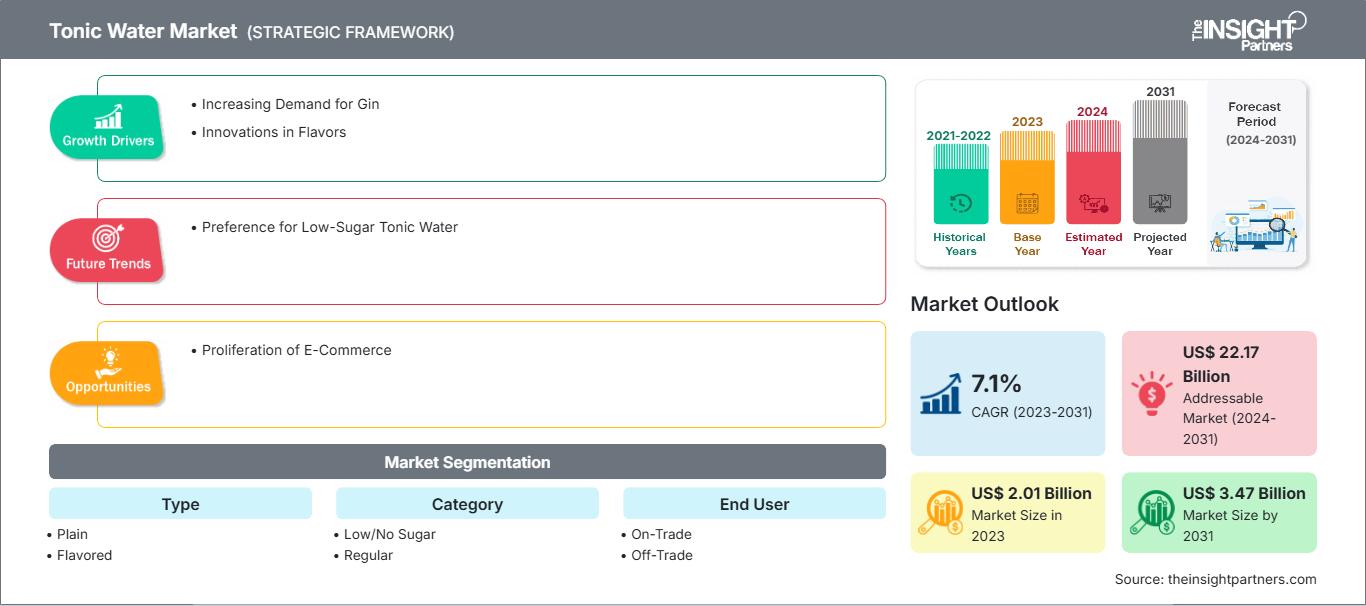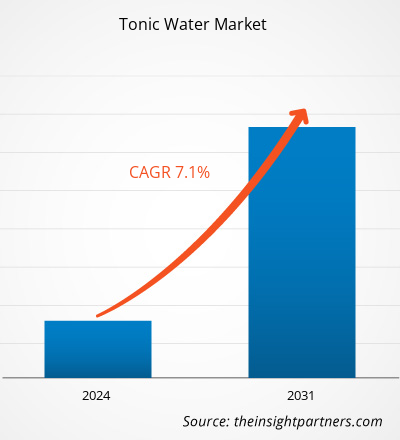Si prevede che il mercato dell'acqua tonica raggiungerà i 3,47 miliardi di dollari entro il 2031, rispetto ai 2,01 miliardi di dollari del 2023. Si prevede che il mercato registrerà un CAGR del 7,1% tra il 2023 e il 2031. La crescente domanda di acqua tonica a basso contenuto di zucchero continuerà probabilmente a essere una tendenza chiave del mercato.
Analisi del mercato dell'acqua tonica
Il crescente consumo di gin è uno dei principali fattori che guidano la crescita del mercato dell'acqua tonica. Le innovazioni negli aromi dell'acqua tonica aiutano i produttori ad affascinare i consumatori con profili aromatici entusiasmanti. Inoltre, si prevede che l'espansione dell'e-commerce offrirà diverse opportunità al mercato dell'acqua tonica per creare prodotti innovativi, crescere e soddisfare le esigenze in continua evoluzione.
Panoramica del mercato dell'acqua tonica
L'acqua tonica è una bevanda analcolica gassata, utilizzata principalmente come miscelatore o base per gin, vodka e altri liquori. È disponibile in un'ampia gamma di gusti, come frutti di bosco, fiori di sambuco e limone amaro. Con il cambiamento dello stile di vita e la crescente preferenza per le bevande premium, la domanda di acqua tonica sta aumentando significativamente negli Stati Uniti, in India, in Giappone, in Australia, nel Regno Unito, in Spagna e in Italia, tra gli altri paesi sviluppati e in via di sviluppo. Le persone in questi paesi preferiscono esplorare nuove esperienze e sapori, il che aumenta la domanda di acqua tonica. Inoltre, la crescente tendenza alla cocktail culture e alle feste notturne tra la Generazione Z e la popolazione dei Millennial si traduce anche in un'impennata della domanda di acqua tonica.
Personalizza questo rapporto in base alle tue esigenze
Potrai personalizzare gratuitamente qualsiasi rapporto, comprese parti di questo rapporto, o analisi a livello di paese, pacchetto dati Excel, oltre a usufruire di grandi offerte e sconti per start-up e università
Mercato dell'acqua tonica: Approfondimenti strategici

- Ottieni le principali tendenze chiave del mercato di questo rapporto.Questo campione GRATUITO includerà l'analisi dei dati, che vanno dalle tendenze di mercato alle stime e alle previsioni.
Potrai personalizzare gratuitamente qualsiasi rapporto, comprese parti di questo rapporto, o analisi a livello di paese, pacchetto dati Excel, oltre a usufruire di grandi offerte e sconti per start-up e università
Mercato dell'acqua tonica: Approfondimenti strategici

- Ottieni le principali tendenze chiave del mercato di questo rapporto.Questo campione GRATUITO includerà l'analisi dei dati, che vanno dalle tendenze di mercato alle stime e alle previsioni.
Fattori e opportunità del mercato dell'acqua tonica
Crescente domanda di crescita del mercato del gin
L'evoluzione delle preferenze e dei gusti dei consumatori ha guidato la domanda di gin in tutto il mondo. Con le persone che esplorano e si abbandonano ai diversi sapori del gin, aumenta anche la richiesta di mixer complementari per migliorare la loro esperienza di consumo. L'acqua tonica, con il suo gusto amaro ma rinfrescante, è l'accompagnamento perfetto per il gin. Pertanto, l'aumento della popolarità del gin ha portato a un corrispondente aumento del consumo di acqua tonica. Inoltre, il gin artigianale sta guadagnando una popolarità significativa in tutto il mondo. Man mano che gli appassionati di gin diventano più esigenti in termini di profili aromatici dei loro distillati, cercano mixer di alta qualità per esaltare i loro cocktail. I marchi artigianali e di piccole dimensioni hanno iniziato a concentrarsi sulla domanda di acqua tonica premium, offrendo un'ampia gamma di acque toniche aromatizzate e arricchite con botaniche che completano le caratteristiche sfumate del gin artigianale. Inoltre, i consumatori sono disposti a pagare prezzi più alti per prodotti di qualità superiore che migliorano la loro esperienza di consumo.
Proliferazione dell'e-commerce per creare opportunità di mercato
Con la crescente popolarità dello shopping online, in particolare nel settore alimentare e delle bevande, i marchi di acqua tonica possono sfruttare le piattaforme di e-commerce per espandere la propria presenza sul mercato e raggiungere una base di consumatori più ampia. Grazie alla presenza online, questi marchi possono entrare in contatto diretto con i consumatori, offrendo un'esperienza di acquisto fluida e comode opzioni di consegna, particolarmente apprezzate dai residenti urbani più dinamici. Il lancio di una piattaforma online dedicata che offre specificamente bevande alcoliche e mixer crea opportunità di crescita per gli operatori del mercato dell'acqua tonica. Nel luglio 2022, A1 Cuisines, azienda proprietaria e produttrice del marchio di acqua tonica Malaki, ha annunciato il lancio di BeverageCart, la prima piattaforma indiana per bevande basata su un'app mobile. L'app mira a facilitare la consegna fluida di bevande a rivenditori, hotel, ristoranti e servizi di catering, evadendo così gli ordini online all'ingrosso. Tali piattaforme offrono una selezione accurata di marchi di acqua tonica premium, offrendo ai consumatori un punto di riferimento unico per le loro esigenze di cocktail.
Analisi della segmentazione del rapporto di mercato dell'acqua tonica
I segmenti chiave che hanno contribuito all'analisi del mercato dell'acqua tonica sono la tipologia di prodotto, la categoria e il canale di distribuzione.
- In base alla tipologia, il mercato dell'acqua tonica è suddiviso in acqua liscia e aromatizzata. Il segmento aromatizzato ha detenuto una quota di mercato maggiore nel 2023.
- Per categoria, il mercato è suddiviso in acqua a basso/senza zucchero e acqua normale. Il segmento acqua normale ha detenuto una quota di mercato maggiore nel 2023.
- In termini di utilizzo finale, il mercato è segmentato in on-trade e off-trade. Il segmento off-trade ha detenuto una quota significativa del mercato nel 2023.
Analisi della quota di mercato dell'acqua tonica per area geografica
L'ambito geografico del rapporto sul mercato dell'acqua tonica è suddiviso principalmente in cinque regioni: Nord America, Asia-Pacifico, Europa, Medio Oriente e Africa e America meridionale e centrale.
L'Europa domina il mercato. Attori chiave come Fever-Tree e Schweppes vantano una presenza significativa nel mercato dell'acqua tonica in Europa. Queste aziende hanno capitalizzato con successo la premiumizzazione lanciando opzioni di acqua tonica di alta qualità realizzate con ingredienti naturali e aromi unici. Nel novembre 2021, Arctic Blue ha annunciato il lancio di acqua tonica prodotta con pura acqua di falda finlandese, un prodotto a basso contenuto di zuccheri e calorie ma gustoso. Inoltre, il lancio di varianti premium di acqua tonica, tra cui offerte artigianali e in piccoli lotti, ha ulteriormente stimolato l'interesse dei consumatori.
Acqua tonicaApprofondimenti regionali sul mercato dell'acqua tonica
Le tendenze regionali e i fattori che influenzano il mercato dell'acqua tonica durante il periodo di previsione sono stati ampiamente spiegati dagli analisti di The Insight Partners. Questa sezione analizza anche i segmenti e la geografia del mercato dell'acqua tonica in Nord America, Europa, Asia-Pacifico, Medio Oriente e Africa, America meridionale e centrale.
Ambito del rapporto di mercato dell'acqua tonica
| Attributo del rapporto | Dettagli |
|---|---|
| Dimensioni del mercato in 2023 | US$ 2.01 Billion |
| Dimensioni del mercato per 2031 | US$ 3.47 Billion |
| CAGR globale (2023 - 2031) | 7.1% |
| Dati storici | 2021-2022 |
| Periodo di previsione | 2024-2031 |
| Segmenti coperti |
By Tipo
|
| Regioni e paesi coperti | Nord America
|
| Leader di mercato e profili aziendali chiave |
|
Densità degli attori del mercato dell'acqua tonica: comprendere il suo impatto sulle dinamiche aziendali
Il mercato dell'acqua tonica è in rapida crescita, trainato dalla crescente domanda da parte dei consumatori finali, dovuta a fattori quali l'evoluzione delle preferenze dei consumatori, i progressi tecnologici e una maggiore consapevolezza dei benefici del prodotto. Con l'aumento della domanda, le aziende stanno ampliando la propria offerta, innovando per soddisfare le esigenze dei consumatori e sfruttando le tendenze emergenti, alimentando ulteriormente la crescita del mercato.

- Ottieni il Mercato dell'acqua tonica Panoramica dei principali attori chiave
Notizie e sviluppi recenti sul mercato dell'acqua tonica
Il mercato dell'acqua tonica viene valutato raccogliendo dati qualitativi e quantitativi dopo ricerche primarie e secondarie, che includono importanti pubblicazioni aziendali, dati di associazioni e database. Di seguito è riportato un importante sviluppo recente nel mercato dell'acqua tonica:
- Fentimans ha introdotto nel Regno Unito una gamma di miscele da 200 ml, allontanandosi dalla tradizionale porzione da 125 ml. La nuova gamma, che include i gusti Acqua Tonica, Ginger Beer e Limonata alla Rosa, sarà realizzata utilizzando la tecnica di produzione botanica di Fentimans, un metodo artigianale centenario, per creare un drink miscelato più lungo, saporito e senza limiti. (Fonte: sito web aziendale, maggio 2024)
Copertura e risultati del rapporto sul mercato dell'acqua tonica
Il rapporto "Dimensioni e previsioni del mercato dell'acqua tonica (2021-2031)" fornisce un'analisi dettagliata del mercato che copre le seguenti aree:
- Dimensioni e previsioni del mercato dell'acqua tonica a livello globale, regionale e nazionale per tutti i segmenti di mercato chiave coperti dall'ambito
- Tendenze del mercato dell'acqua tonica e dinamiche di mercato come fattori trainanti, vincoli e opportunità chiave
- Analisi dettagliata delle cinque forze di Porter e SWOT
- Analisi del mercato dell'acqua tonica che copre le principali tendenze del mercato, il quadro globale e regionale, i principali attori, le normative e i recenti sviluppi del mercato
- Analisi del panorama industriale e della concorrenza che copre la concentrazione del mercato, l'analisi della mappa termica, i principali attori e i recenti sviluppi per il mercato dell'acqua tonica
- Profili aziendali dettagliati
- Analisi storica (2 anni), anno base, previsione (7 anni) con CAGR
- Analisi PEST e SWOT
- Valore/volume delle dimensioni del mercato - Globale, Regionale, Nazionale
- Industria e panorama competitivo
- Set di dati Excel
Report recenti
Rapporti correlati
Testimonianze
Motivo dell'acquisto
- Processo decisionale informato
- Comprensione delle dinamiche di mercato
- Analisi competitiva
- Analisi dei clienti
- Previsioni di mercato
- Mitigazione del rischio
- Pianificazione strategica
- Giustificazione degli investimenti
- Identificazione dei mercati emergenti
- Miglioramento delle strategie di marketing
- Aumento dell'efficienza operativa
- Allineamento alle tendenze normative




















 Ottieni un campione gratuito per - Mercato dell'acqua tonica
Ottieni un campione gratuito per - Mercato dell'acqua tonica